
Elevating Security: The Essential Role Of Third-Party Risk Management
According to a 2022 survey conducted by Gartner, 84% of executive risk committee members of organisations say that “misses” in third-party risk disrupt their business operations. Additionally, 62% of data breaches are attributed to vulnerabilities in third-party relationships.
These statistics are concerning, especially because a majority of organisations maintain extensive relationships with vendors, suppliers, and partners for goods and services, to drive business innovation and operational efficiency.
As Jeff Hudgens, the vCISO at Pratum says,
“Your risk management strategy isn’t just about what you do. It’s about what your vendors are doing too.”
Therefore, it is evident that, while your organisation must have a resilient cybersecurity framework, it is just as important for your third-party suppliers to uphold a robust security stance.
According to a study by KPMG, 73% of organisations have experienced at least one significant disruption from a third-party cyber incident within the last four years.
So how do most organisations manage the risks associated with these third parties, also known as third-party risks?
They provide proper funding, visibility, and resources to conduct a third-party risk assessment and then respond to threats from the risks they find, also known as third-party risk management.
As your organisation experiences rapid growth to meet client demands, its need to use more third-party vendors grows, highlighting the importance of well-structured vendor risk management for sustainable operations.
Did you know that the third-party risk management market size in 2021 was valued at USD 4.45 billion and is expected to grow to USD 14.33 billion by 2030?
This anticipated growth in TPRM demand has brought about a steep rise in the significance of advanced third-party risk management software platforms that can make a remarkable difference in how organisations handle the associated risks.
What Is A Third-Party Risk Management Software?
The cyber risks involved in onboarding and entrusting your organisational data to a multitude of third-party vendors cannot be overlooked. These risks may include data breaches, security vulnerabilities, compliance issues, and other cybersecurity threats that can arise from the involvement of external entities.
Therefore your organisation needs to implement dedicated risk management software or tools to address potential cybersecurity risks.
A third-party risk management software is a specialised technology designed to assist your organisation in identifying, evaluating, and mitigating cybersecurity risks associated with its relationships with third-party vendors or partners.
A TPRM software empowers your organisation to screen and integrate the right vendors by subjecting each to a vendor risk assessment template through the following steps:
Conduct a thorough examination of third-party vendors and providers through meticulous vendor risk assessment (VRA) questionnaires and market research data. This approach establishes a risk-scoring mechanism, facilitating your organisation in the selection of vendors aligned with its specific needs.
Continuously assess the performance and diligence of third-party vendors, evaluating their IT and business framework in real-time for any indicators that could pose reputational, legal, or financial risks to your organisation.
Implement a consistent strategy for vendor onboarding and off-boarding workflows. This approach enables your organisation to define expectations clearly, optimise operations, and instil transparency and accountability into its interactions with third-party entities.
Enhance Risk Management, Improve Compliance, And Reduce Costs With Third-Party Risk Management Software
Your organisation should consider investing in a third-party risk management software platform due to the benefits mentioned below:
Improve Risk Management
A third-party Risk Management (TPRM) software automates your organisation’s risk management process, allowing it to detect, evaluate, and address risks associated with third-party vendors.
Strengthen Regulatory Compliance
A TPRM software can assist your organisation in aligning with regulatory standards, such as GDPR, DPDP 2023, HIPAA, and SOX, by actively monitoring and reporting on vendor compliance.
Enhance Vendor Selection
By adopting TPRM software you can enable your organisation to evaluate vendor risk before onboarding, ensuring associations exclusively with vendors that meet your defined risk criteria.
Improve Cost Savings
A TPRM software minimises the time and effort needed to handle vendor risks, allowing your organisation’s resources to be redirected towards other crucial activities.
Safeguard Reputation
A TPRM software protects your organisation’s reputation by validating that vendors meet your desired ethical and compliance criteria.
Key Components to Look For In TPRM Solutions
When assessing TPRM software for your organisation, you must consider these crucial features:
Centralised storage for due diligence documents, contracts, assessments, and related information, all stored in a comprehensive vendor database.
Comprehensive risk scoring utilising vendor questionnaires, financial stability, historical performance, and other relevant metrics.
Automation of workflows for tasks such as onboarding, approvals, renewals, and offboarding processes.
Real-time tracking and alerts for service disruptions, security events, financial changes, compliance lapses, and related notifications.
Customised templates for risk assessment, and evaluating vendors following internal policies and external regulations.
Analysis and reporting tools designed for scrutinising vendor data, risk profiles, and ongoing performance trends.
Smooth integration with existing systems, including procurement, Enterprise Resource Planning (ERPs), and Governance, Risk and Compliance (GRC) platforms.
A strong security posture for any organisation requires vigilance not just internally, but across your entire ecosystem. By implementing comprehensive third-party risk management software, you establish a proactive shield against potential security breaches.
However, effective third-party risk management isn’t a one-time effort. It’s an ongoing process requiring continuous assessment, monitoring, and adaptation. By dedicating resources to this crucial aspect of cybersecurity, not only do you protect valuable customer and company data, but it also allows you to safely expand your organisation’s third-party network, ensuring business growth.

